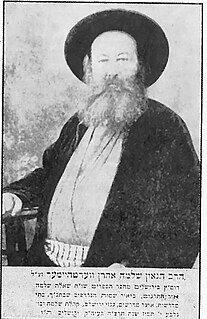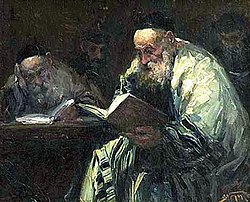Moshe haDarshan was chief of the yeshiva of Narbonne, and perhaps the founder of Jewish exegetical studies in France. Along with Rashi, his writings are often cited as the first extant writings in Zarphatic, the Judæo-French language.

Rabbi Solomon Aaron Wertheimer, was a Hungarian rabbi, scholar, and seller of rare books.
Tobiah ben Eliezer was a Talmudist and poet of the 11th century, author of Lekach Tov or Pesikta Zutarta, a midrashic commentary on the Pentateuch and the Five Megillot.

Sifre refers to either of two works of Midrash halakha, or classical Jewish legal biblical exegesis, based on the biblical books of Numbers and Deuteronomy.

Midrash Abkir is one of the smaller midrashim, the extant remains of which consist of more than 50 excerpts contained in the Yalkut Shimoni and a number of citations in other works. It dealt, according to all accessible evidence, only with the first two books of the Pentateuch.

Midrash Tadshe is a small midrash which begins with an interpretation of Gen. 1:11:
"And God said, Let the earth bring forth". R. Pinchas asked, "Why did God decree that grass and herbs and fruits should grow upon the third day, while light was not created until the fourth? To show His infinite power, which is almighty; for even without the light He caused the earth to bring forth [while now He creates all manner of trees and plants through the operation of the light]."

The Mekhilta of Rabbi Shimon bar Yochai is a Halakic midrash on Exodus from the school of Rabbi Akiva, attributed to Shimon bar Yochai. No midrash of this name is mentioned in Talmudic literature, but medieval authors refer to one which they call either "Mekhilta de-R. Simeon b. Yohai" or "Mekhilta Ahrita de-R. Shimon", or simply "Mekhilta Akheret".

Midrash Aseret ha-Dibrot or Midrash of the Ten Statements is one of the smaller midrashim which dates from about the 10th century, and which is devoted entirely to the Shavuot holiday; a Vatican library manuscript in fact calls it "an aggadah for Shavuot."

Midrash Petirat Moshe or Midrash on the Death of Moses is one of the smaller midrashim. This midrash describes in great detail the last acts of Moses and his death, at which the angels and God were present. There are several recensions of it, dating to between 7th and 11th centuries. The first, published at Constantinople in 1516 begins with a brief exegesis by R. Samuel Naḥmani and R. Tanhuma of the first verse of the pericope "V'Zot HaBerachah", closing with its last verses, and doubtless intended for Simhat Torah. In 1693, the Midrash was translated into yiddish by Aaron ben Samuel, leading to its popularization with women.

Midrash Esfah is one of the smaller midrashim, which as yet is known only from a few excerpts in Yalkut Shimoni and two citations in Sefer Raziel and Ha-Roḳeaḥ.

The Chronicle of Moses is one of the smaller midrashim. In this midrash, which is written in pure (pseudo-biblical) Hebrew, and which is in many portions only provides a mere hint of verses from the Bible in a close imitation of Biblical style, is presented a history of the life of Moses embellished with many legends.

Midrash Vayisau is one of the smaller midrashim. This small midrash, "the heroic legend of the sons of Jacob," is based on Genesis 35:5 and 36:6, and recounts the story of the wars of Jacob and his sons against the kings of the Amorites and against Esau and his army.

Midrash Al Yithallel is a small midrash containing stories from the lives of the wise Solomon, the mighty David, and the rich Korah, illustrating Jeremiah 9:23, whence comes the title:
Thus said the Lord: Let not the wise man glory in his wisdom ; Let not the strong man glory in his strength ; Let not the rich man glory in his riches. But only in this should one glory: In his earnest devotion to Me. For I the Lord act with kindness, justice, and equity in the world; For in these I delight —declares the Lord.

Midrash Eleh Ezkerah is an aggadic midrash, one of the smaller midrashim, which receives its name from the fact that a seliḥah for the Day of Atonement, which treats the same subject and begins with the words "Eleh ezkerah," recounts the execution of ten famous teachers of the Mishnah in the time of the persecution by Hadrian. The same event is related in a very ancient source, Eichah Rabbah.

Midrash Eser Galiyyot is one of the smaller midrashim and treats of the ten exiles which have befallen the Jews, counting four exiles under Sennacherib, four under Nebuchadnezzar, one under Vespasian, and one under Hadrian. It contains also many parallels to the Seder 'Olam, ch. xxii. et seq.

Midrash Maaseh Torah is one of the smaller midrashim, and contains compilations of doctrines, regulations of conduct, and empirical rules, arranged in groups of three to ten each and taken from various works. It is frequently found in manuscript, and has been edited at Constantinople (1519), Venice (1544), Amsterdam (1697), and elsewhere, while it has appeared more recently in A. Jellinek's B. H. and is contained also in the Kol Bo, where it frequently deviates from the Amsterdam edition even in the arrangement of its sentences.

Midrash Taame Haserot ve-Yeterot is one of the smaller midrashim.

Midrash Veyechulu is one of the smaller midrashim, named after Genesis 2:1. It contained both halakhic and aggadic material, and doubtless covered several books of the Pentateuch; but it now exists only in citations by various authors after the middle of the 12th century.

'Midrash Hashkem, also known as Midrash ve-Hizhir, is an aggadic and halachic midrash on the Pentateuch. It roughly follows the Torah from Exodus 8 to Numbers 20.
Sefer Zerubavel, also called the Book of Zerubbabel or the Apocalypse of Zerubbabel, is a medieval Hebrew apocalypse written at the beginning of the 7th century CE in the style of biblical visions placed into the mouth of Zerubbabel, the last descendant of the Davidic line to take a prominent part in Israel's history, who laid the foundation of the Second Temple in the 6th century BCE. The enigmatic postexilic biblical leader receives a revelatory vision outlining personalities and events associated with the restoration of Israel, the End of Days, and the establishment of the Third Temple.


